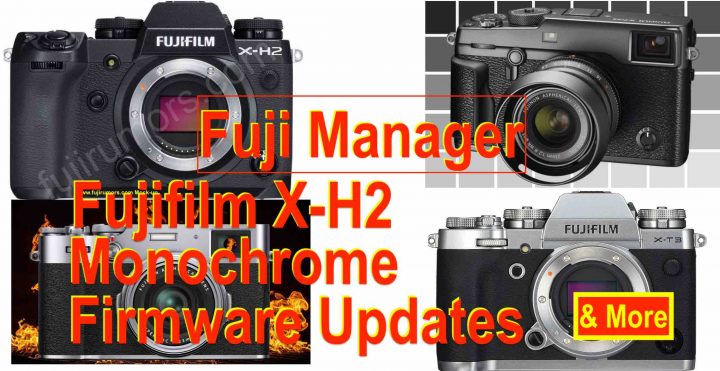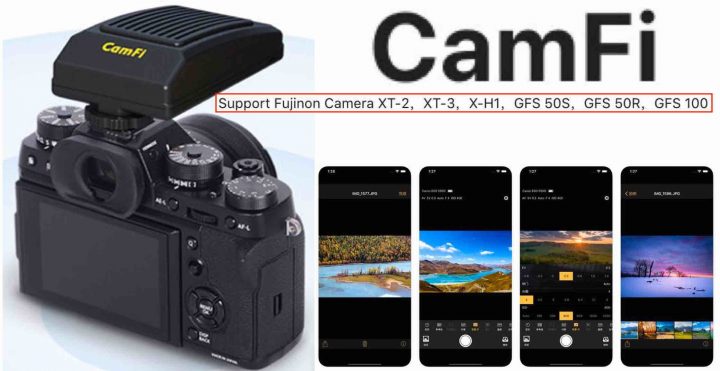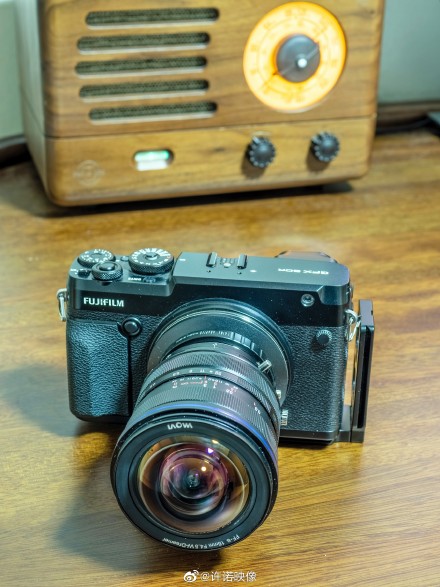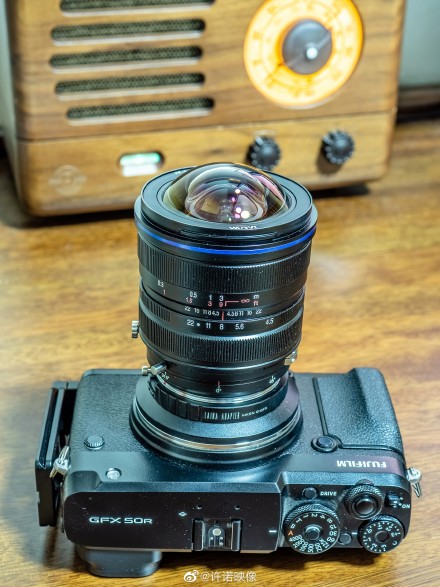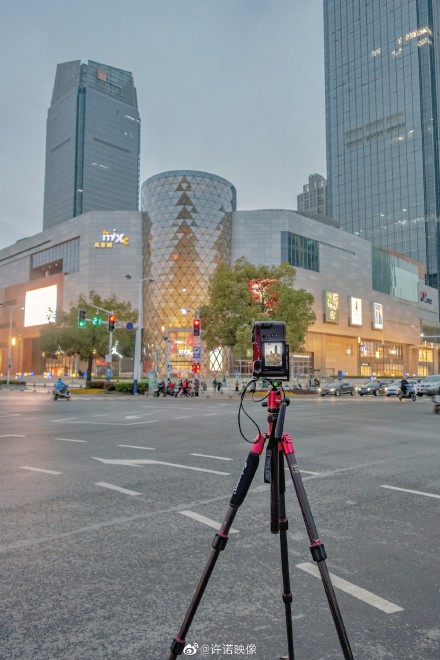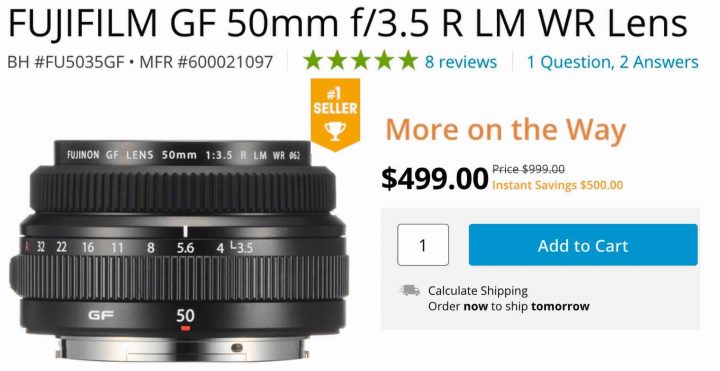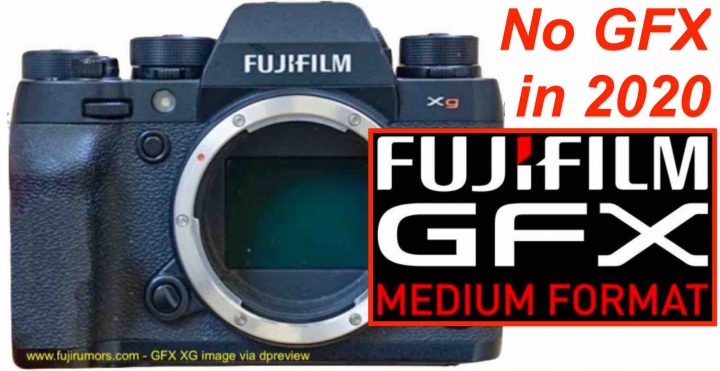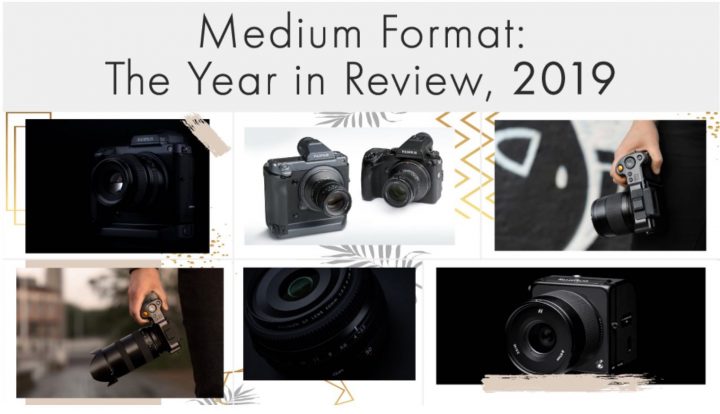CamFi Adds Wireless Tethering Support for Fujifilm Cameras
A few days ago, CamFi has just released a new version of their wireless tethering app that adds support for the following Fujifilm cameras.
- Fujifilm X-T2
- Fujifilm X-T3
- Fujifilm X-H1
- Fujifilm GFX 50R
- Fujifilm GFX 50S
- Fujifilm GFX 100
CamFi products can be found at BHphoto and AmazonUS.
You can download the CamFi App at the Apple Store here and at Google Play Store.
What’s New
Apr 3, 2020
Version 3.7.1
- Support Fujinon Camera X-T2, X-T3, X-H1, GFX 50S, GFX 50R, GFX 100
- Support Sony a6100, a6600
- Support Canon 90D
Top Fujifilm Manager Toshi Iida Talks Fujifilm X-T4, Strong X-T4 Pre-orders, How COVD-19 Affects Fujifilm, GFX vs FF, Anamorphic Lenses and More
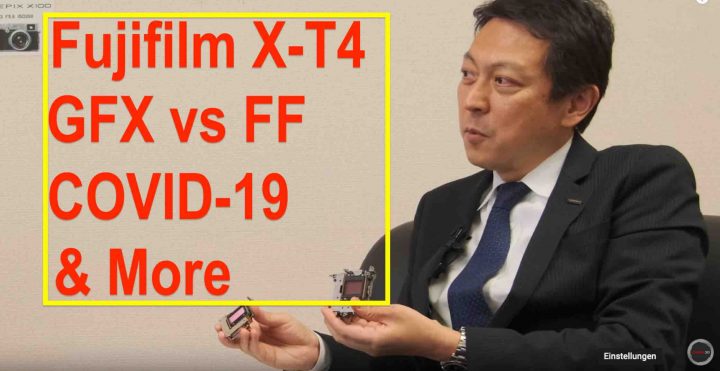
Cinema5D interviewed top Fujifilm manager Toshi Iida.
It’s a 20 minutes interview I urge you to watch, but if you are in a hurry, here is what the manager says in a quick and practical summary. You can find the full video below.
How COVID-19 Affects Fujifilm
Laowa 15mm f/4.5 Shift Full Frame Lens on Fujifilm GFX – First Sample Images
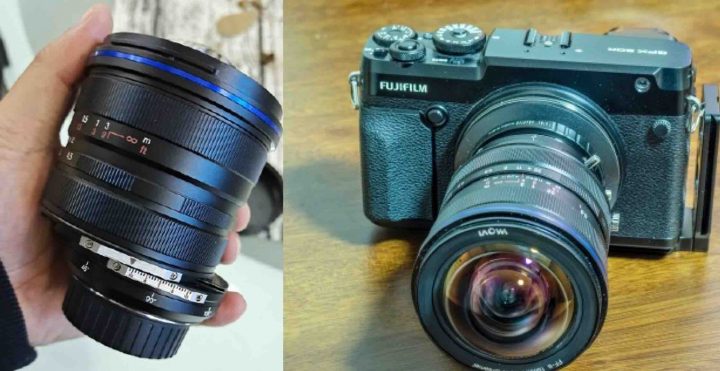
Venus Optics will soon launch the Laowa 15mm f/4.5 W-Dreamer shift lens for full frame cameras.
Now we have some sample images and we can give a few more details about how this full frame lens works on the Fujifilm GFX medium format system.
According to a beta tester, the Laowa 15mm f/4.5 W-Dreamer shift lens can be used on Fujifilm GFX, but the ability to shift is limited to ± 7.
Here is his the feedback the Chinese beta tester gave so far:
Although the image field of the shift lens is much larger than the ordinary 135 format lens, if the offset is too large (± 7 or more) on the 44×33 format, it will still have a dark angle
@ 老 frog lens 15-axis image field perfectly covers the 4433 sensor, visually there is 5mm up and down, and 3mm left and right shift amount
@ 老 frog lens 15-axis transfer to Fuji GFX 50R, the picture quality looks pretty good, even if it is an ordinary ultra-wide-angle lens, the perspective is very strong. Blessed 4433 users
Join FujiRumors on Patreon, Facebook, Instagram, RSS-feed, Youtube, Flipboard and Twitter
Images and text via weibo.
Fujifilm X-T4: D-Pad or No D-Pad? The Answer in This Article!
I still remember, when back in August 2017, I shared a rumor, that many of you thought is wrong, but it turned out correct: Fujifilm will remove the D-Pad from the Fujifilm X-E3.
Since then, many Fujifilm cameras saw the loss of the D-Pad:
- Fujifilm GFX100
- Fujifilm GFX50R
- Fujifilm X-T30
- Fujifilm X-Pro3
- Fujifilm X100V
- Fujifilm X-A7
- Fujifilm X-T200
Even the huge Fujifilm GFX100, that definitely has enough real estate to host a D-Pad, didn’t get one.
Well, I am happy to report, that the Fujifilm X-T4 will remain a welcome exception to this trend and keep the D-Pad, just as the X-T3 did.
The Fujifilm X-T4 will be announced February 25/26. You can find the precise X-T4 announcement time in your country here.
Join FujiRumors on Patreon, Facebook, Flipboard, Youtube, Instagram, RSS-feed and Twitter
The Fujinon GF50mmF3.5 is 50% off and Immediatly Out of Stock, plus Other Fujifilm X/GFX Savings up to $1,000
Last Monday Fujifilm launched new Fujifilm X/GFX deals, with, among the others a 50% rebate on the Fujinon GF 50mm f/3.5
It needed just few hours, and the lens run out of stock basically everywhere, and still today it is out of stock at BHphoto and Adorama, and AmazonUS.
If you are interested, put yourself in the waiting list and order soon, to avoid even longer waiting times.
With that said, here is the full list of deals.
- Fujifilm GFX 50R (save $1,000): BHphoto, Adorama, AmazonUS
- Fujinon GF 50mm F3.5 (save $500): BHphoto, AmazonUS, Adorama, Focuscamera
- Fujifilm X-T3 body (save $200 + Free Vertical Grip): BHphoto, AmazonUS, Adorama, Focuscamera
- Fujifilm X-T3 + XF16-80 (save $200 + Free Vertical Grip): BHphoto, Adorama, AmazonUS, Focuscamera
- Fujifilm X-T3 + XF18-55 (save $200 + Free Vertical Grip): BHphoto, AmazonUS, Adorama, Focuscamera
- Fujifilm X-T30 body (save $100): BHphoto, Adorama, AmazonUS, FocusCamera
- Fujifilm X-T30 + XF 18-55 (save $200): BHphoto, Adorama, AmazonUS, FocusCamera
- Fujifilm X-T30 + XC 15-45 (save $150): BHphoto, Adorama, AmazonUS, FocusCamera
Software
- Capture One 20
- DeNoise AI software
- Adobe Creative Cloud
- Luminar 4 – save $10 with code “FUJI”
- Aurora HDR
- Photolemur
- Picktorial
- ON1 Photo RAW
General Deal Pages
All Fujifilm Deals
Used Fujifilm Gear
Official Fujifilm Recommended Accessories
SD-Cards
Power Banks
EXCLUSIVE: No New Fujifilm GFX Camera Coming in 2020. We have to Wait until 2021 – Trusted Source
Fujifilm GFX
Hey folks!
I have a very important update for you.
I recently got dozen of emails of worried people, who were about to order a Fujifilm GFX 50S/R camera.
The reason?
Everybody thought, that the last mysterious registered camera, the FF190003, would be a GFX camera, and hence they would buy gear that would be about to be replaced.
But after FujiRumors unveiled them all (X-T4, X-T200 and X100V), they proceeded with their order.
With the name of all imminent cameras leaked, everybody came to the logical conclusion, that there are no GFX cameras that are close to releasing.
But I am here today to tell you it is actually worse than that!
Thanks to our trusted sources, I am now able to tell you, that there will NOT be ANY new Fujifilm GFX camera in 2020!
I believe that the Fujifilm GFX has a enormous potential and if developed at a proper pace, could be a fantastic alternative to all other camera systems out there.
By waiting so long with new GFX cameras, the risk is that Fujifilm could miss the boat and lose the momentum that is bringing so many full frame shooters into the GFX system.
But let’s try to see things positive:
- if you purchase a GFX now, you can be sure you won’t be surprised by any successor in 2020
- the long wait could mean that Fujifilm does not want to offer a minor MKII upgrade, but something more substantial
- Fujifilm could free up resources to put into the development of Fujinon GFX lenses
Anyway, in 2020, the Fujifilm GFX camera lineup will still consist in:
- Fujifilm GFX100 – announced May 2019
- Fujifilm GFX50R – announced September 2018
- Fujifilm GFX50S – announced February 2017
So this will be the first year, where we do not get a new Fujifilm GFX camera.
Let’s Enjoy the Mirrorless Price War – Last Day (Maybe) to Save $1,000 on Fujifilm X/GFX Gear
eXtended X/GFX Deals
In theory, this is the last day of Fujifilm X and GFX deals. I say in theory, as lately Fujifilm (and all other manufacturers), just keep up chronically discounting all their gear. See for example:
- Canon EOS R (save $500)
- Sony A7III (save $200)
- Nikon Z series (save up to $950 on bundles)
The drastically shrinking camera market triggered a battle for survivor, which is surely stressful for companies, but it’s mostly good for us customers, as this competition gives us innovation and the latest and greatest at a cheaper price than ever.
There is a downside, though, also for customers, as this inevitably means that our lovely gear loses value faster.
But if you were looking at your gear as an “investment“, then here is a tip: electronic goods are never good for that. You don’t even have time to unbox your brand new gear at home, that it already lost value.
Is there a thing in life that has only Pros? Well, let me know if there is, because I still haven’t found it. And so it is in the case of the deals. We can decide to be annoyed by the Cons, or just try to enjoy the Pros of it.
With that said, down below is the full list of deals, that will end on January 5th, but in some shape or form will come back surely later this year.
Full List of Fujifilm X / GFX Deals
GFX Deals
- Fujifilm GFX 50S + battery grip (save $1,000): BHphoto, Adorama
- Fujifilm GFX 50R (save $500): BHphoto, Adorama, AmazonUS,
- Fujifilm GFX 50S (save $500): BHphoto, Adorama
- GF 23mm F4 (save $500): BHphoto, AmazonUS, Adorama
- GF 45mmF2.8 (save $500): BHphoto, Adorama, AmazonUS
- GF 63mmF2.8 (save $500): BHphoto, Adorama, AmazonUS
- GF 110mm F2 (save $500): BHphoto, AmazonUS, Adorama
- GF 120mmF4 (save $500): BHphoto, Adorama, AmazonUS
- GF 250mm F4 (save $500): BHphoto, Adorama, AmazonUS
- GF 32-64mmF4 (save $500): BHphoto, Adorama, AmazonUS
- GF 100-200mm f/5.6 (save $500): BHphoto, AmazonUS, Adorama
X Camera Deals
- X-T3 body only (save $200): BHphoto, AmazonUS, Adorama, Focuscamera
- X-T3 + XF16-80 (save $200): BHphoto, Adorama, AmazonUS, Focuscamera
- X-T3 + XF56mm F1.2 R (save $500): BHphoto, AmazonUS, Adorama, Focuscamera
- X-T3 + XF16mm F1.4 R WR (save $500): BHphoto, AmazonUS, Adorama, Focuscamera
- X-T3 + XF10-24mm F4 R OIS (save $500): BHphoto, AmazonUS, Adorama, Focuscamera
- X-T3 + XF18-55mm (save $200): BHphoto, AmazonUS, Adorama, Focuscamera
- X-Pro2 (save $400): BHphoto, AmazonUS, Adorama
- X-Pro2 Graphite with 23/2 (save $700): BHphoto, AmazonUS, Adorama, Focuscamera
- *X-H1 + grip (save $300): BHphoto, Adorama, AmazonUS, Focuscamera
- *X-H1 + grip + 8-16mmF2.8 (save $1,000):BHphoto, Adorama, AmazonUS, Focuscamera
- *X-H1 + grip + 16-55mmF2.8 (save $800): BHphoto, Adorama, AmazonUS, Focuscamera
- *X-H1 + grip + 18-135mmF2.8 (save $700): BHphoto, Adorama, AmazonUS, Focuscamera
- *X-H1 + grip + 90mmF2 (save $700): BHphoto, Adorama, AmazonUS, Focuscamera
- X-T30 body (save $100): BHphoto, Adorama, AmazonUS, FocusCamera
- X-T30 + XF 18-55 (save $200): BHphoto, Adorama, AmazonUS, FocusCamera
- X-T30 + XC15-45 (save $150): BHphoto, Adorama, AmazonUS, FocusCamera
- X-T30 + XC15-45 and XC50-230 (save $300): BHphoto, Adorama, AmazonUS, FocusCamera
- X-T20 body or kit (save $200): BHphoto, Adorama, AmazonUS, FocusCamera
- X-E3 body or kit (save $200): BHphoto, Adorama, AmazonUS, FocusCamera
- X100F (save $200): BHphoto, Adorama, AmazonUS, Focuscamera
- X-T100 (save $150): BHphoto, AmazonUS, Adorama, Focuscamera
*Note that the X-H1 is discontinued in many stores
XF Prime Lenses
- XF 14mmF2.8 (save $100): BHphoto, AmazonUS, Adorama, Focuscamera
- XF 16mmF1.4 WR (save $100): BHphoto, AmazonUS, Adorama, Focuscamera
- XF 23mmF1.4 (save $100): BHphoto, AmazonUS, Adorama, Focuscamera
- XF 56mmF1.2 APD (save $150): BHphoto, AmazonUS, Adorama, Focuscamera
- XF 56mmF1.2 (save $100): BHphoto, AmazonUS, Adorama, Focuscamera
- XF 80mmF2.8 OIS WR (save $250): BHphoto, AmazonUS, Adorama, Focuscamera
- XF 90mmF2 WR (save $100): BHphoto, AmazonUS, Adorama, Focuscamera
XF Zoom Lenses
- XF 8-16mm F2.8 (save $200): BHphoto, Adorama, AmazonUS, Focuscamera
- XF 10-24mmF4 OIS (save $100): BHphoto, AmazonUS, Adorama, Focuscamera
- XF 16-55mmF2.8 WR (save $200): BHphoto, AmazonUS, Adorama, Focuscamera
- XF 18-135mmF3.5-5.6 OIS WR (save $100): BHphoto, AmazonUS, Adorama, Focuscamera
- XF 50-140mmF2.8 OIS WR (save $200): BHphoto, AmazonUS, Adorama, Focuscamera
- XF 100-400mmF4.5-5.6 OIS WR (save $200): BHphoto, AmazonUS, Adorama, Focuscamera
General Deal Pages
All Fujifilm Deals
Used Fujifilm Gear
Official Fujifilm Recommended Accessories
SD-Cards
Power Banks
Software
2019: The Year of Medium Format – Powerful Versatility, Leaving Canon FF for Fujifilm GFX and More
2019 – Medium Format Year
The crowd of photographer shooting digital medium format is growing, also thanks to the Fujifilm GFX system.
The lens system is growing, the camera line expanding and all what happened in the medium format world in 2019 can be checked out at BHphoto here.
As a recognition to that, DPReview declared the Fujifilm GFX100 “innovation of the year“.
Today we dedicate a roundup to the Fujifilm GFX system.
You’ll find people, who left Canon full frame for Fujifilm GFX100, reviews, images and more. Check it all out down below
The GFX Community
Follow FujiRumors: Facebook, Flipboard, Instagram, RSS-feed, Youtube and Twitter
GFX Reviews
- imaging-resource – Fujifilm GFX 100 Review Conclusion: The most versatile medium-format camera ever made?
- blog.kasson – GFX 100 w/ Fuji 45/2.8 vs a7RIV w/ Sigma 35/1.2
- blog.kasson – Fuji 45 mm f/2.8 on GFX 100
- patricemichellon – the Fujifilm GFX 50R
- williamchua – Photo showcase of Xiapu taken with the GFX 100
- josejeuland – Fujifilm GFX 50R in New Delhi
- 5050travelog – Fujifilm GFX 50R – Camera Review
- peterziegler – GFX 50R + X-H1
- fstoppers – Review of the Fujifilm GF 50mm f/3.5 R LM WR
Fujifilm X and GFX Deals Extended until January 5, 2020
eXtended X/GFX Deals
Fujifilm decided to extend the deals on Fujifilm X and GFX gear until January 5, 2020.
Check out down below the updated list of deals.
- B&H Photo has launched the Mega Deal Zone
- Holiday deals on BHphoto here
- Happy Holiday Deals on AmazonUS here
- Holiday Gifts at Adorama here
Full List of Fujifilm X / GFX Deals
GFX Deals
- Fujifilm GFX 50S + battery grip (save $1,000): BHphoto, Adorama
- Fujifilm GFX 50R (save $500): BHphoto, Adorama, AmazonUS,
- Fujifilm GFX 50S (save $500): BHphoto, Adorama
- GF 23mm F4 (save $500): BHphoto, AmazonUS, Adorama
- GF 45mmF2.8 (save $500): BHphoto, Adorama, AmazonUS
- GF 63mmF2.8 (save $500): BHphoto, Adorama, AmazonUS
- GF 110mm F2 (save $500): BHphoto, AmazonUS, Adorama
- GF 120mmF4 (save $500): BHphoto, Adorama, AmazonUS
- GF 250mm F4 (save $500): BHphoto, Adorama, AmazonUS
- GF 32-64mmF4 (save $500): BHphoto, Adorama, AmazonUS
- GF 100-200mm f/5.6 (save $500): BHphoto, AmazonUS, Adorama
X Camera Deals
- X-T3 body only (save $200): BHphoto, AmazonUS, Adorama, Focuscamera
- X-T3 + XF16-80 (save $200): BHphoto, Adorama, AmazonUS, Focuscamera
- X-T3 + XF56mm F1.2 R (save $500): BHphoto, AmazonUS, Adorama, Focuscamera
- X-T3 + XF16mm F1.4 R WR (save $500): BHphoto, AmazonUS, Adorama, Focuscamera
- X-T3 + XF10-24mm F4 R OIS (save $500): BHphoto, AmazonUS, Adorama, Focuscamera
- X-T3 + XF18-55mm (save $200): BHphoto, AmazonUS, Adorama, Focuscamera
- X-Pro2 (save $400): BHphoto, AmazonUS, Adorama
- X-Pro2 Graphite with 23/2 (save $700): BHphoto, AmazonUS, Adorama, Focuscamera
- *X-H1 + grip (save $300): BHphoto, Adorama, AmazonUS, Focuscamera
- *X-H1 + grip + 8-16mmF2.8 (save $1,000):BHphoto, Adorama, AmazonUS, Focuscamera
- *X-H1 + grip + 16-55mmF2.8 (save $800): BHphoto, Adorama, AmazonUS, Focuscamera
- *X-H1 + grip + 18-135mmF2.8 (save $700): BHphoto, Adorama, AmazonUS, Focuscamera
- *X-H1 + grip + 90mmF2 (save $700): BHphoto, Adorama, AmazonUS, Focuscamera
- X-T30 body (save $100): BHphoto, Adorama, AmazonUS, FocusCamera
- X-T30 + XF 18-55 (save $200): BHphoto, Adorama, AmazonUS, FocusCamera
- X-T30 + XC15-45 (save $150): BHphoto, Adorama, AmazonUS, FocusCamera
- X-T30 + XC15-45 and XC50-230 (save $300): BHphoto, Adorama, AmazonUS, FocusCamera
- X-T20 body or kit (save $200): BHphoto, Adorama, AmazonUS, FocusCamera
- X-E3 body or kit (save $200): BHphoto, Adorama, AmazonUS, FocusCamera
- X100F (save $200): BHphoto, Adorama, AmazonUS, Focuscamera
- X-T100 (save $150): BHphoto, AmazonUS, Adorama, Focuscamera
*Note that the X-H1 is discontinued in many stores
XF Prime Lenses
- XF 14mmF2.8 (save $100): BHphoto, AmazonUS, Adorama, Focuscamera
- XF 16mmF1.4 WR (save $100): BHphoto, AmazonUS, Adorama, Focuscamera
- XF 23mmF1.4 (save $100): BHphoto, AmazonUS, Adorama, Focuscamera
- XF 56mmF1.2 APD (save $150): BHphoto, AmazonUS, Adorama, Focuscamera
- XF 56mmF1.2 (save $100): BHphoto, AmazonUS, Adorama, Focuscamera
- XF 80mmF2.8 OIS WR (save $250): BHphoto, AmazonUS, Adorama, Focuscamera
- XF 90mmF2 WR (save $100): BHphoto, AmazonUS, Adorama, Focuscamera
XF Zoom Lenses
- XF 8-16mm F2.8 (save $200): BHphoto, Adorama, AmazonUS, Focuscamera
- XF 10-24mmF4 OIS (save $100): BHphoto, AmazonUS, Adorama, Focuscamera
- XF 16-55mmF2.8 WR (save $200): BHphoto, AmazonUS, Adorama, Focuscamera
- XF 18-135mmF3.5-5.6 OIS WR (save $100): BHphoto, AmazonUS, Adorama, Focuscamera
- XF 50-140mmF2.8 OIS WR (save $200): BHphoto, AmazonUS, Adorama, Focuscamera
- XF 100-400mmF4.5-5.6 OIS WR (save $200): BHphoto, AmazonUS, Adorama, Focuscamera
General Deal Pages
All Fujifilm Deals
Used Fujifilm Gear
Official Fujifilm Recommended Accessories
SD-Cards
Power Banks

